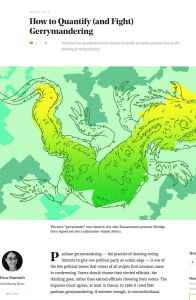Join getAbstract to access the summary!

Join getAbstract to access the summary!
Erica Klarreich
How to Quantify (and Fight) Gerrymandering
Powerful new quantitative tools are now available to combat partisan bias in the drawing of voting districts.
Quanta, 2017
What's inside?
Mathematicians crack their way into the gerrymander debate.
Recommendation
Gerrymandering – the redrawing of voting maps to provide one party with an unfair advantage in elections – has just gotten a lot more sophisticated. Clever gerrymandering can virtually guarantee a party’s majority for years to come – even if it has a minority in the state overall. Voters from the left and the right condemn partisan gerrymandering, but how do you show that a map indeed favors one party over another? Writing for Quanta Magazine, Erica Klarreich explains which quantitative techniques mathematicians suggest to measure gerrymandering and discusses whether it’s intentional. getAbstract recommends this article to lawmakers, politicians and the US electorate.
Summary
About the Author
Erica Klarreich, PhD, has written about science and mathematics for more than a decade. She earned her doctorate in mathematics from Stony Brook University.
















Comment on this summary